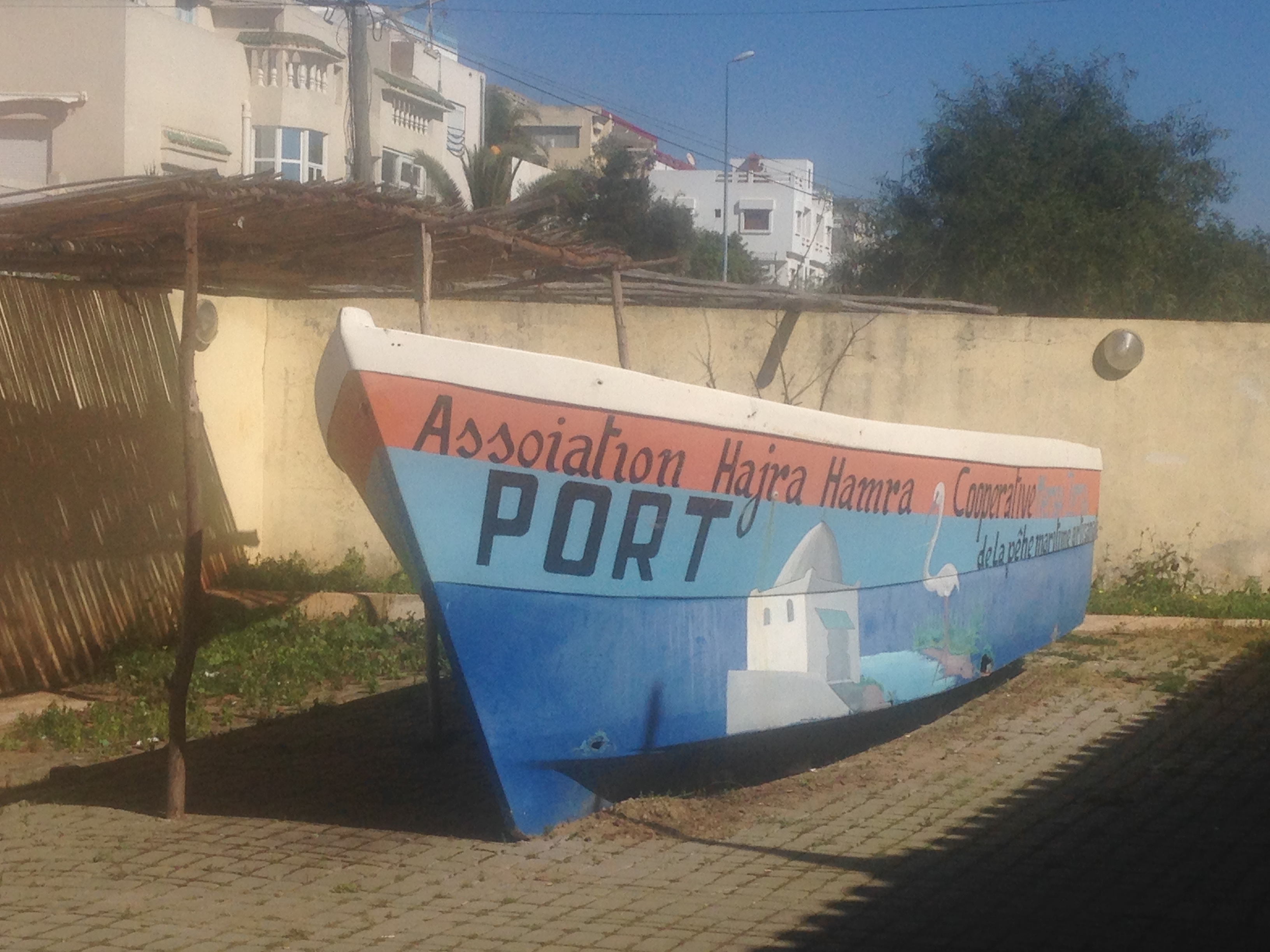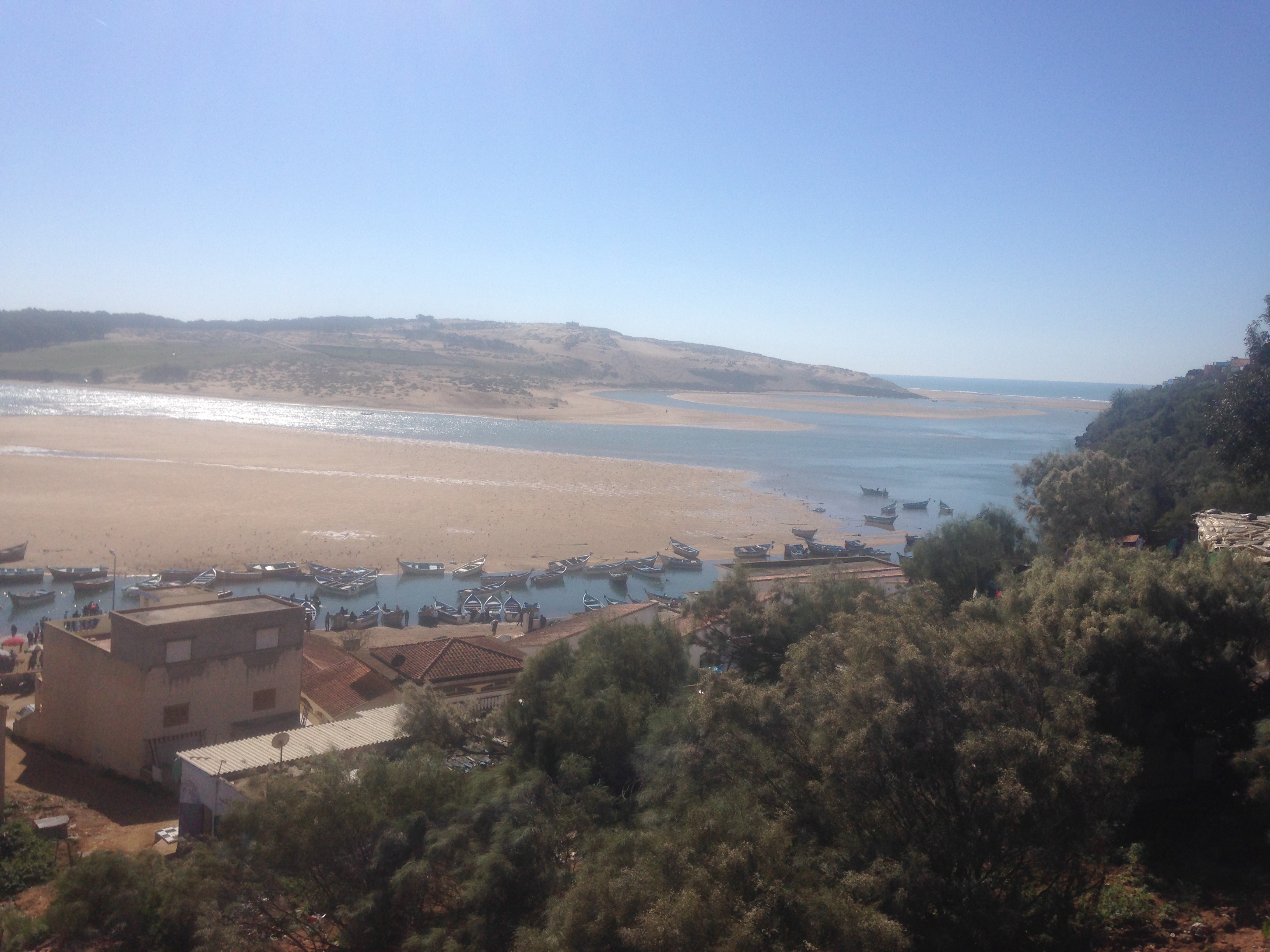Fes to Moulay Bosselham and Tangier Med
Meknes, Moulay-Idriss
On the day before we left Fes we decided to do a short circular ride-out from Camping International taking in Meknes and a small town called Moulay Idriss. In all, the route was about 120miles in total. The day was bathed in warm sunshine and it was a pleasurable ride. The first 30 miles was on the National Route N6; uninspiring. The road, though well made, was boringly flat, wide and straight for the most part.
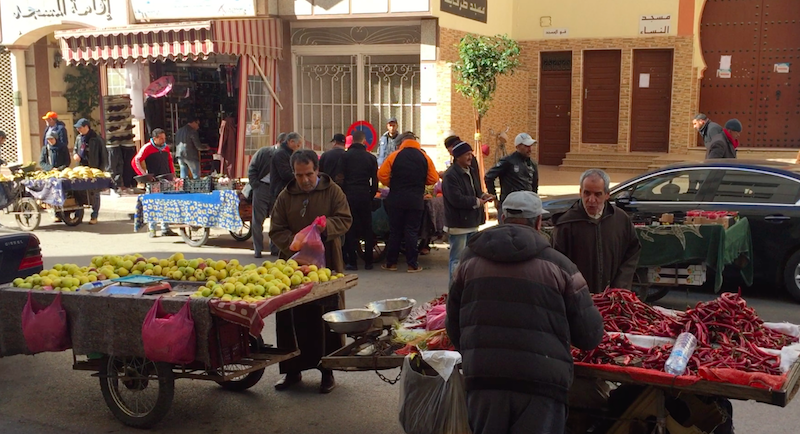
After following a local bus, and absorbing it’s fumes for several miles, we arrived in Meknes. The journey took around an hour. We drifted through the traffic filled streets of this modern city, looking for somewhere to park. After a while we found a vacant car parking space and pulled into it. Immediately we were approached by an official looking, but amicable guy in a fluorescent vest. He indicated that the space we occupied was for cars only, but beckoned to a place on the pavement where we could put the bikes. We still don’t know the official status of these ‘parking attendants’ but they appeared in most of the towns we visited. For the donation of a few Dirhams they not only park you, but will guard the bikes while you are away. Even the helmets were left with the bikes and remained unmolested until our return. Much of the Moroccan economy seems to work this way, begging, though rare, is seen as an acceptable economic activity. It is not uncommon to walk a street and see a series of identically small provision stores virtually side by side.
We had a tea break in a street cafe and considered our options. It had become too hot to contemplate wandering around this modern part of the city, in our biking gear. There was, apparently, an ancient medina, but it was some way off and we had had our fill in Fes. We handed over a few coins to the smiling guardian of parking, mounted our steeds and with the aid of iMaps we were soon out of town.

After a short ride we climbed the road winding into the town of Moulay-Idriss. As we approached, we ignored the gesticulating locals and found ourselves a perfect parking spot without any assistance. The day had become warm and sunny, possibly too warm for wearing biking gear, as we wandered into the town. Idriss was typical of the small towns we had encountered, built into the steep terrain with narrow winding streets. We had successfully fended of the attentions of an insistent young man who kept offering to show us the sights and continued to drift around the maze of streets until, after some time, we had to backtrack from the blind alley we had reached. Looking like lost tourists we were easy prey to a pleasant older man who, encouraged by our apparent confusion, latched on to us. He had closed and locked the tiny store he had been supervising and joined us with a smile. The views from the small terraces dotted around the town were spectacular but after 10 mins we were tired and in need of refreshment. The airy town square was encircled by restaurants and shops with a large mosque on one side; a pleasant place to watch the world go by. Eventually we had to return to the campsite in Fes and ready ourselves for decamping and hitting the road; destination Rabat.
Rabat
We had decided to avoid the main, and busiest roads whilst traveling in Morocco, and as a result of this policy had found some excellent rural byways. Our route to the Atlantic passed through countryside which consisted of rolling hills of cultivated land. We halted for liquid refreshment at a roadside halt, here we became objects of some curiosity especially, I suspect, when Jen removed her helmet. Although French is the country’s second language, in rural places, Arabic is often the only spoken language. The tea we had ordered, after some confusion, arrived and was a full bodied infusion of various leaves; without milk.

By late afternoon we arrived at the coast, the only campsite we could find was closed; our problems had begun. After being directed to an accommodation; the middle of a roundabout in the middle of nowhere, then riding around looking for an hotel without success, we were rescued by a knight in shining armour, in the unlikely guise of a small delivery truck. The driver, spotting us sitting on a kerbstone, peering into the glowing iphone, commanded we follow him to a ‘good hotel’. A frantic pursuit through the, now darkened, busy streets of Rabat ensued, with us desperately hanging onto the back of a furiously driven truck, finally we halted in front of the opulent sprawl of the Hotel Spa Dawliz. The driver refused, absolutely, to accept any reward. “You are a guest in my country” he proclaimed and handed Jen a chocolate bar. We shook hands and waved furiously as our saviour disappeared. The uniformed guards lifted the barrier and parked us close by, so that they might provide all night security for the bikes. Though thoroughly dishevelled and wearing our grubby bike gear the receptionist was charming, even when she discovered we were ‘walk ins’, without a reservation. The room was huge, the bed was huge and we were hugely knackered. We spread our gear liberally around the room in order to make it more homely and, after a spruce up, went down to the bar for an expensive beer.
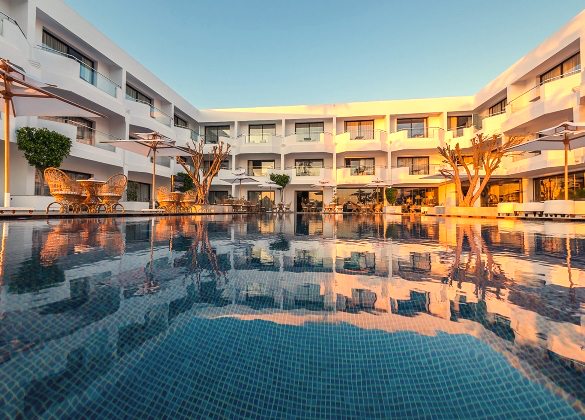
The following morning, after an expansive breakfast, we left the hotel and it’s panoramic views of Rabat beyond the adjacent river and turned north away from the city. A perusal of the map had revealed a large,coastal, lagoon about 100 miles to the north of Rabat; we all know that lagoons mean birds, lots and lots of birds. We had decided to use the main autoroute, with it’s tolls, trucks and fast moving traffic. There was a, cold, coastal mist settling on the road and surrounding countryside which rendered the ride uncomfortably unpleasant. After a few hours we were thankful to reach the exit for Moulay Bousselham, the fog had lifted and the day was warm and sunny as we rode the handful of miles to town.
Moulay Bousselham
Moulay Boussalem is a small fishing port with a natural, protected haven at the seaward end of the lagoon. There are floating moorings where numerous sturdy looking open boats are stationed. The moorings are shielded by a large sandbar almost separating the lagoon from the Atlantic beyond, with a small natural channel allowing access to the fishing grounds. The boats, with their high, sharp prows, are able to punch their way through the shoreline surf to reach the bounty beyond. From tiny sardines and sprats to large tuna and sharks the variety of the fish landed is vast. What cannot be sold on the beach is carted away on the ubiquitous three wheeled pickup trucks to local markets and beyond. The campsite is adjacent to the beach where the catch is landed, a tranquil field with sheep and horses replacing lawnmowers. The services are a little archaic and the hot water supply intermittent, but the atmosphere is slow paced and relaxing. A small on site restaurant and it’s smiling young manager, supplies mint tea, delicious food and wifi.
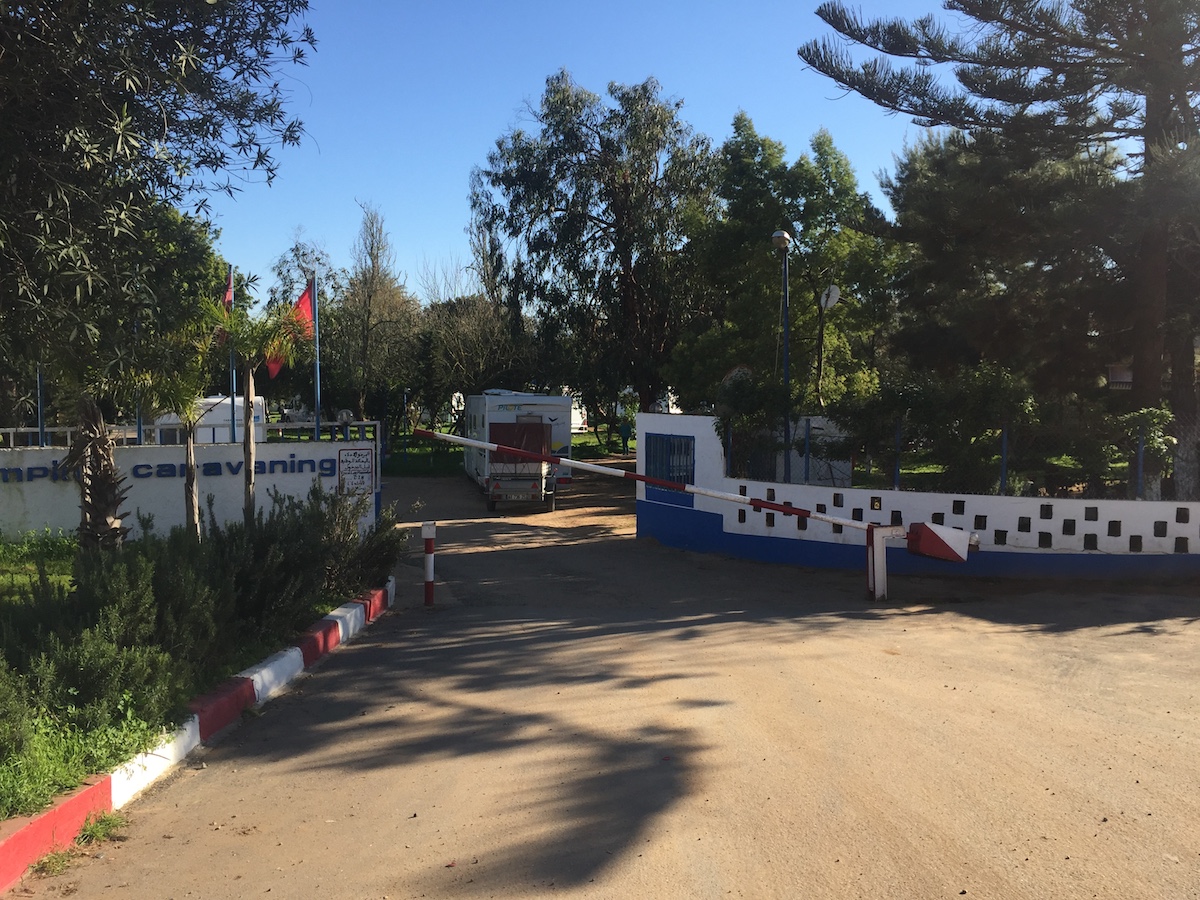
Much of the town sits on the cliffs overlooking the beach and lagoon. Several restaurants supply a variety of food and a small market behind them sells fresh fish, vegetables, fruit and ‘cook while you wait’ street food. We ate at one restaurant, sitting on a rickety wooden terrace, a lookout to the western horizon, the sun was setting with one of those vivid displays that sear the memory, as well as the retina.
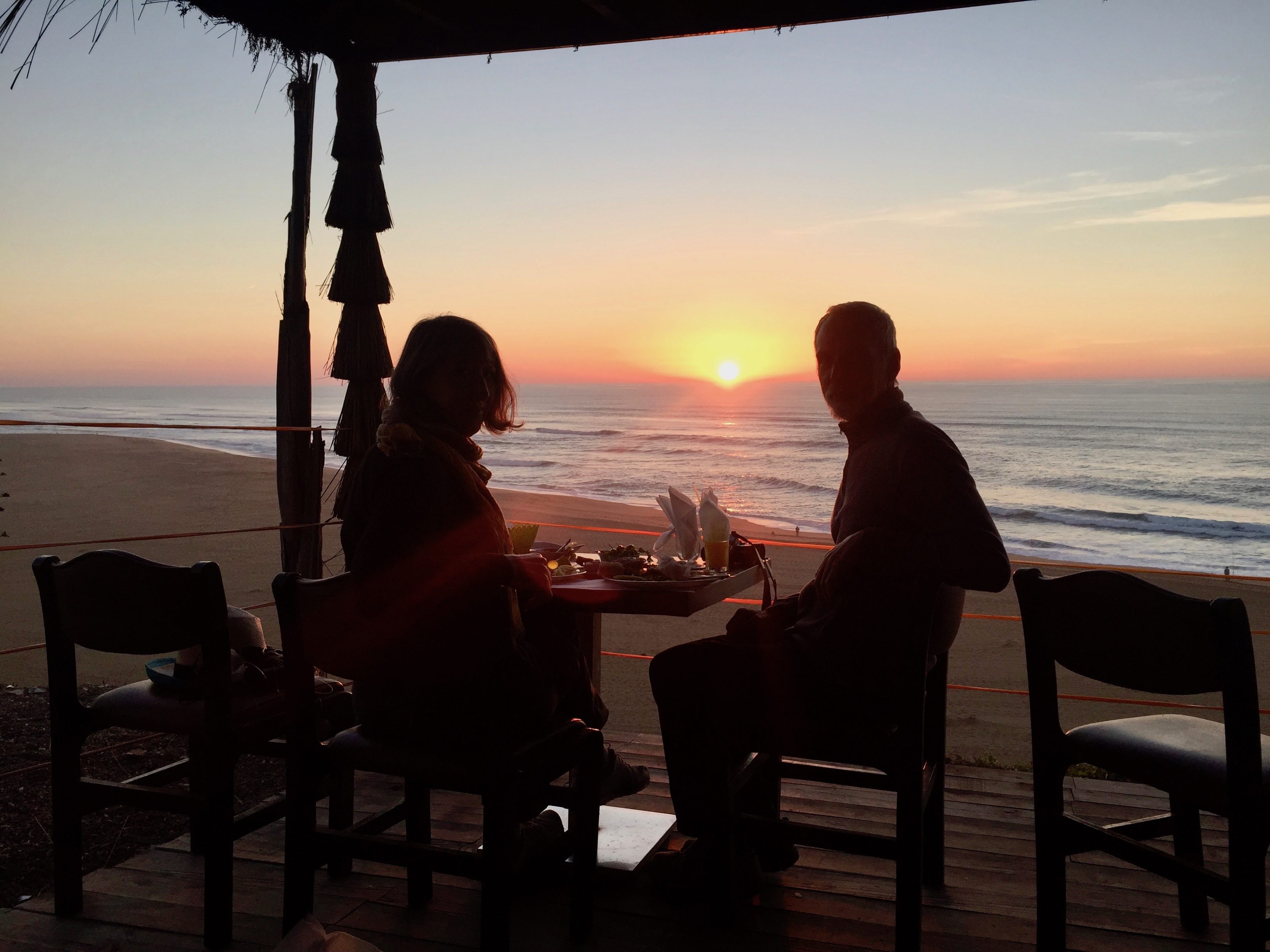
During our stay we met Omar and his extended family, took a trip around the lagoon, shared a fresh fish BBQ with John from the UK and had an in depth political discussion with a ‘comrade’ from the Chinese royal family. These are the magical things that happen when you extend your horizons. At times you will feel unsettled, or anxious ,or even fearful; more often you will feel welcomed, sometimes admittedly for your wealth, but also because people want you to be happy and safe in their country.
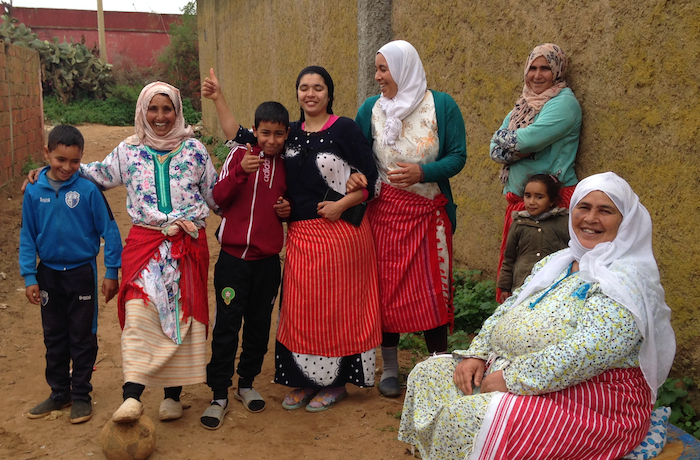
We had finally to tear ourselves away from Moulay Bousselham and head for Spain. This would be our last full day in Morocco and rather than trek around the coast we decided to enjoy our last day in the hills. We had booked a B & B in Ksar-es-Seghir 5 minutes from the port. Unfortunately it was very windy which rather spoilt the ride. This was more than compensated for by the comfort afforded by the ‘Villa Marine’, attentive staff, great food and the bikes under lock and key.

Tangier Med
Okay the ferry was more than 5 minutes away; by about two minutes and we did spend much of the day shivering in the windy docks (see our other blog posts). We finally boarded late in the afternoon, after arriving dockside before ten in the morning.
Summary
Would we recommend Morocco? Short answer is ‘without doubt’. You will feel gently hassled on occasion, but many of the people that approach you are just trying to get by. The Moroccans are very tolerant of anyone trying to earn a crust and we tried to be the same. We saw very little begging, we also met many people who were trying to redistribute some of our wealth to their benefit. Try not to loose a sense of proportion or humour. Do not, as I did, get stroppy over being charged the equivalent of less than two quid for two teas! Smile a lot, learn the Arabic for hello, please and thank-you. Sometimes paying a guy, £40 for seven hours of his time, is a small price to pay for better understanding of his culture. The people of Morocco, at least most of the ones we met, are happy, helpful people. Like the good socialist I am, I say ‘share the wealth brothers’.

